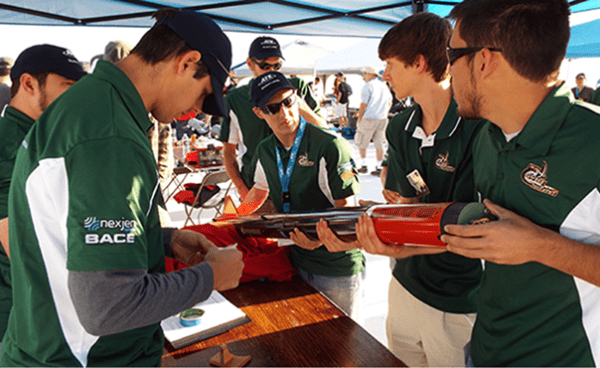49er rocket team wins top NASA design award

UNC Charlotte’s rocket team, comprised of engineering students, won the prestigious “Vehicle Design Award” at the NASA University Student Launch competition recently held at the Bonneville Salt Flats in Tooele County, Utah.
The 49er team was one of 31 university teams from across the country to enter the competition. Twenty-two of the teams made it to Utah, and of those 17 made it to the launch pad.
“I am so proud of this team,” said Karen Thorsett-Hill, a lecturer in mechanical engineering and the team’s faculty mentor. “It is really quite an accomplishment to have NASA, ATK and other Space Launch System affiliates bestow upon our team one of the most prestigious awards in this competition.”
According to NASA, the Vehicle Design Award is presented “for the most creative, innovative and well-constructed overall vehicle design for the intended payload while maximizing safety and efficiency.”
The official review of the UNC Charlotte rocket design stated that the team “provided detailed analysis for design decisions, both computer-based as well as analysis done by hand, with all work shown. The team provided accurate and detailed Computer Aided Drawing models that clearly showed how the different systems and subsystems were integrated. The team constructed its own carbon fiber airframe and components, and the quality of construction and finish was outstanding.”
The Lee College of Engineering team was made up of two electrical and seven mechanical engineer students: Jerry Dahlberg, John Cappalletti, Daniel Deese, Dewey Greer, Benjamin Griffiths, Matthew Perry, Daniel Saulnier, Robert Stone and Caleb Watts.
The requirements for the competition were that teams design and construct a reusable prototype rocket capable of reaching 4,900 feet. The payload had to include, but was not limited to, a ground hazard surveillance camera and a strain measurement system.
“Payload integration was probably the most challenging part of the design,” said Jerry Dahlberg, the project team student lead for UNC Charlotte. “We started by designing the payload first. Then we designed the vehicle around it, so it could be as small and efficient as possible.”
The team also added two other systems to its payload. These were an atmospheric sensor package that could measure temperature, pressure, humidity and solar irradiance, and a thrust modulation system that could control the rocket’s ascent in order to reach the desired altitude.
“We were the only ones to add other elements to our payload,” Dahlberg said. “We definitely did things nobody else even thought about. Our system integration and our payload creativity is what helped us win.”
During its year-long development of the rocket, the team performed five half-scale tests and three full-scale flight tests. They had a few problems with the motors supplied by a manufacturer on a couple full-scale tests but were reaching their altitude targets. Unfortunately in Utah, they had another malfunction in a motor, which blew up upon launch and the rocket only went a few hundred feet into the air.
“We had what they call a ‘catastrophic event at takeoff,’” Dahlberg said. “We were disappointed we didn’t come home in one piece, but we were very happy with our results. We had a great team and good teamwork all year long.”
The 49er team was funded by the North Carolina Space Grant Consortium, the Lee College of Engineering and its Senior Design program and the Mechanical Engineering and the Electrical and Computer Engineering departments. Support was provided by NexGen, BACE and Carolina Composite Rocketry, too.